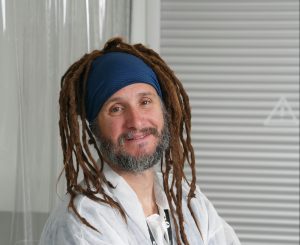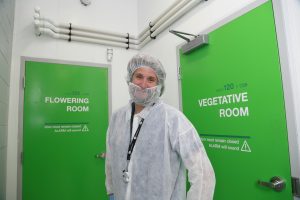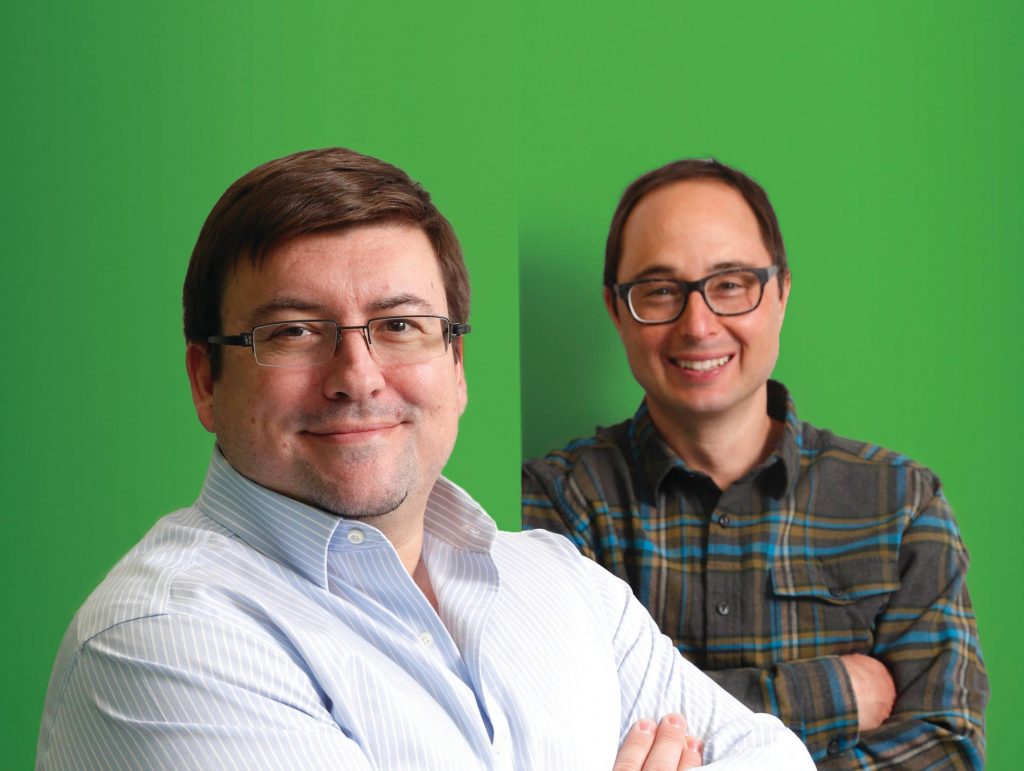Growing Opportunities
London’s first licensed cannabis production facility gets set for
domestic distribution–and sets the stage to go global
Photo: Indiva president and CEO, Niel Marotta, and COO and general counsel, Koby Smutylo
THE UPCOMING BASEBALL season is the final year before Washington Nationals outfielder Bryce Harper becomes a free agent at age 25. There has been speculation for at least two years that once he reaches that point, he will sign the richest contract in baseball history, eclipsing the current record, $325-million for new Yankee Giancarlo Stanton.
Unlike so many free agents, Harper will just be entering the prime of his career when he goes to auction. Given that, together with his generational talent and potential, the consensus is that $400 million is just the entry point teams will bid to sign him.
(Don’t get excited Blue Jays fans: Toronto is not among the teams expected to land him.)
Although Pete Young is roughly twice as old as Bryce Harper, does not play baseball and is unknown to a single Major League team, he has something in common with the young superstar: He knows what it’s like to be in demand.
Five years ago, federal medical marijuana regulations began to evolve. Change came in fits and starts and included a legal challenge that helped shape the Marijuana Medical Access Regulations. Health Canada began accepting applications to grow and sell medical grade marijuana. And by so doing, it helped transform Pete Young and others like him across the country from crusading outsider to valued industry expert.

Companies that wanted to get in on the early stages of what was predicted to be a huge market needed expertise and credibility to navigate the complicated licence approval process. Just as the Chicago Cubs reportedly are willing to pay vast sums to have Bryce Harper play centre field for them in 2019, nascent marijuana companies were willing to pay Young a smaller, but still hefty, sum to validate their applications.
“I was offered six figures just for my email list. They
didn’t actually want me to be involved, just to use my
name and contacts” —Pete Young
With 30 years of experience growing and advocating for marijuana, Young is a rare and valuable commodity. “I had people approach me,” he says. “I was offered six figures just for my email list. They didn’t actually want me to be involved, just to use my name and contacts. Some wanted my expertise, but I wasn’t comfortable with what they were doing.”
He was involved with an early application, but it ran out of money and time. That’s when Young was contacted by two guys in Ottawa, neither of whom he knew, neither of whom knew anything about growing marijuana—until five years ago.
In 2013, Niel Marotta was working as an investment advisor in Ottawa, a decade after leaving Boston. There, he had run a $600-million mutual fund for Fidelity Investments, one of the company’s most successful when he left.
“One of my office neighbours in Ottawa was a lawyer, Koby Smutylo. We would have coffee and he would tell me I should be helping my clients raise money to invest in pot,” Marotta recalls. “He kept telling me this, until finally, in 2014, I really looked into it. There was a massive change underway for the medical marijuana market, along with the framework for recreational use. We didn’t realize how the landscape was going to change, but with just the medical market, it was worth pursuing.”
Marotta and Smutylo teamed up and looked around for the best way to get into the market. That’s when they found the application in London, out of funds but still in partnership with its best asset: Pete Young.
It was application No. 52 to grow medical marijuana, queued up in the Health Canada approval process. There are over 80 today, across the country.
They named the company Indiva, a mashup of cannabis varieties. By taking over an existing application, the Ottawa partners could jump ahead a year or more. The only catch was a peculiar provision of all applications to Health Canada. They are tied to the location from which they are filed. Not just the city, but the actual physical address.
To take over the London application, they had to continue operating from the building the original applicants had leased. And that’s when Smutylo, and especially Marotta, became frequent fliers between Ottawa and London.
“I’m still based in Ottawa, but I basically live here now,” Marotta says, without a hint of regret.
If there is regret, it may come from the building itself, which has all the charm of an East German prison, at least on the outside. Among a cluster of commercial and industrial buildings on Hargrieve Road in the southeast corner of the city, it stands out for its extra security. A steel gate deters visitors, as does the locked front door. Once inside, visitors are asked if they have been exposed to live cannabis plants that day. Regulations require employee security checks.
Inside, a warren of hallways and offices includes a call centre; walls and doors are painted in vibrant colours to reflect the image of the company.
In contrast to the haphazard appearance of the offices, there’s a much more secure section that looks more like a hospital. It has stainless steel tables and three types of exotic lighting. Workers wear face nets and booties and tend to the plants with more care than greenskeepers at Augusta National.
From cutting, to flower, to harvest, the process takes up to 10 weeks, depending on the variety. After a curing process that can take up to six weeks, it’s flash frozen, ensuring freshness and consistency. The name Indiva comes from the two main strains of the plant: Indica—the strain that is sedating—and Sativa—the strain that gives the brain a boost and can be used to treat depression or fatigue.

It was only because Marotta and Smutylo were committed to excellence that Young chose to join the company and stick with the application. “When Indiva approached me, they had the right answers. We want to make money, but we need to do it the right way. We need to do what’s best for the end user. That means quality over quantity.”
Late last year, Indiva raised $23 million and began trading on the TSX Venture Exchange (NDVA). The money will help expand the 10,000-square-foot facility to 40,000 square feet and increase production tenfold. The employee count will double to 40 by year end, including an expanded call centre. For now, that’s how the company will take orders. You don’t just drop off a medical marijuana prescription at your local Rexall and pick it up an hour later. Not yet anyway.
Having received its cultivation licence last fall, the company is a licensed producer and will harvest its first crop soon. Once Health Canada inspects its labs, packaging and product, it will receive permission to begin selling. That is expected in the next two or three months, meaning the first sales should happen in Q2 this year.
This year’s expansion will allow it to grow about 300 kgs of dry flower production, which translates into about three million grams of medical marijuana. Indiva expects to sell for about $8 per gram. But that is just the start of Marotta’s plans.
“We need to get bigger, ten or 20 times bigger,” he says. “We will need to produce at least 50 million grams to be viable.”
That would account for five per cent of the very roughly estimated Canadian market of one billion grams annually for medical and recreational use. The truth is no one really knows what size the market will be, but Indiva is betting on big, not small. If all 80-plus companies vying for licenses right now have similar goals, it also means some are going to fail.
Imagine if you were pioneering the first radios so they could be used by police and fire officials to communicate about emergencies—among themselves and as a way of warning the public. The need for emergency communication was undeniable, and manufacturers were gearing up to profit handsomely from the new technology.
“We need to get bigger, ten or 20 times bigger. We will need to produce at least 50 million grams to be viable” — Niel Marotta
Then one day someone played some music on the radio. Listeners loved it. Cars were equipped with radios. People loved that even more. Sure, they still got emergency notices over the radio, but mostly they used it for entertainment.
By Marotta’s reckoning, Indiva would have been successful if it only ever sold medical marijuana. In 2014, there were 200,000 Canadians using it for medical treatments.
That was the basis on which he and Smutylo acquired a defunct mining company, Rainmaker Resources, shelled it out and used it to acquire the Indiva assets in a reverse takeover. That was the basis on which they bet heavily on Pete Young’s reputation, passion and skill as a master grower. And that was the basis on which they raised millions of dollars and took the company public.
When it begins selling this year, it will be to patients who have prescriptions and are looking for a stable, reliable supplier to fill them. Those patients will call Indiva and order up to a month’s supply at a time, which will arrive discreetly in the mail. Because Indiva has taken its time and planned for long-term expansion, it will not run out of marijuana between harvests. It will be there for its patients, just as Young has been there for people for three decades.
With strong roots, if you will, Indiva will be ready for the recreational market, in whatever form it eventually takes. It’s gearing up for a time, possibly as early as 2019, when the federal government approves the sale of oils, creams and edibles. Like any crop, freshness and quality will matter.
“Our goals are always quality and authenticity, producing medical grade marijuana in a high-tech facility,” Marotta says. “We think people will want the best, whether it’s for medical or recreational use.”
Regardless of how large the Canadian market becomes, it will be dwarfed by demand in other countries, particularly Europe where public opinion is well ahead of North America. That’s the promised land for Indiva and other licensed producers in Canada. Just as Canadian wheat is exported around the world and has a great reputation, Canadian pot could follow suit.
When Indiva gets to that point, it will have left its East German prison behind long ago. It will operate multiple growing facilities, in London and likely elsewhere. That’s the plan anyway. And its architects drew it up with a clear head. ![]() Christopher Clark
Christopher Clark
To read more about Indiva and the emerging marijuana market, visit Christopher Clark’s blog here.

